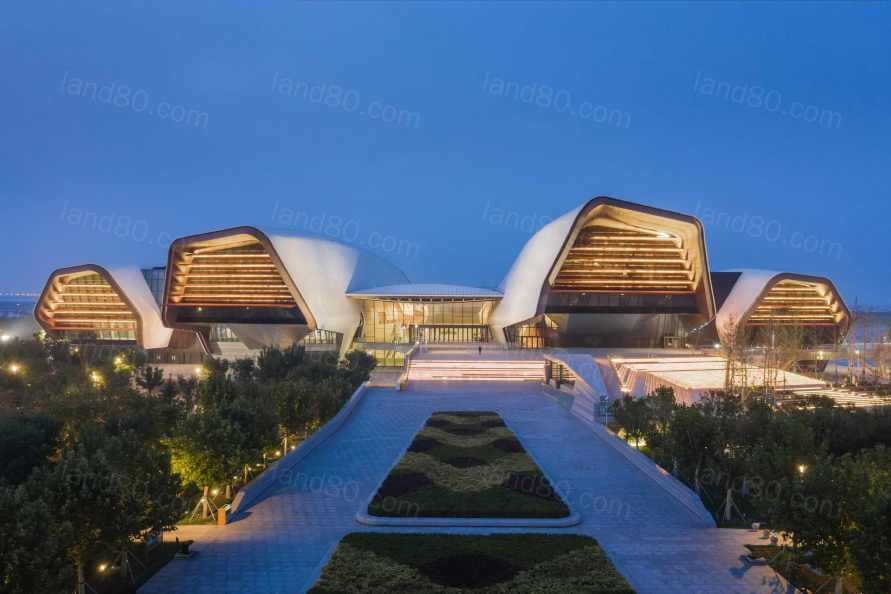中国第一座国家海洋博物馆现已正式投入使用,这是历时6年,从国际设计竞赛开始,到紧锣密鼓地设计和建设的结果。博物馆的造型别具一格,从一个大型滨水公园伸向海湾,其背后是一个名为滨海新区的天津市新城区,目前正在进行开发。
China's first National Maritime Museum has now commenced formal operation, the culmination of a 6-year process which began with an international design competition, followed by an intensive design and construction process. The Museum has a distinctive form which reaches out into the bay from a large waterfront parkland, behind which a new city district of Tianjin, called the Binhai New Area is currently being developed.

这是一个由个体量组成的标志性项目,主要围绕 "远古海洋"、"今日海洋"、"探索之旅 "和 "龙的时代 "等主题展开。博物馆共三层,占地8万平方米,包含6个展示区和15个展厅。这些展厅相互连接,使参观者有机会了解和解读中国的海洋演变与欧洲、美洲以及更广泛的亚洲的事件的关系。
It is a landmark project comprising four wings, focusing on the themes of "the ancient ocean," "ocean today," "journey of discovery" and "the age of the dragon". The three-storey museum, covering 80,000 square meters and containing six display areas and 15 exhibition halls. These halls are interconnected so that visitors are provided an opportunity to understand and interpret China’s maritime evolution in relation to events in Europe, America, and wider Asia.

COX建筑事务所在2013年赢得了为期8个月的反复设计竞赛过程,包括多个阶段的客户和利益相关者的反馈后,获得了该项目。该建筑由一系列相互连接的亭子组成,这些亭子从一个中央接待大厅以 "扇形 "的形式悬垂在水面上。这个中央空间既是过渡空间,也是展览空间,并提供了通往两个展览层的上层的通道。在下层,非展览藏品的储藏室被安排在现场,以便于将艺术品分配到相邻的各个展览空间。
COX Architecture was awarded the project in 2013 after winning an 8-month iterative design competition process involving multiple stages of client and stakeholder feedback. The building comprises a series of interconnected pavilions that cantilever out over the water in a ‘fan-like’ formation from a central reception hall. This central space is both for transition and exhibition and provides access to the upper of the two exhibition levels. On the lower level, stores for non-exhibited collections are co-located on-site to enable artefacts to be easily distributed to each of the adjacent exhibition spaces.

从Philip Cox最初的水彩画草图开始,设计不断发展,某些令人信服的隐喻被解决或出现--跳跃的鲤鱼、珊瑚、海星、停泊在港口的船只,以及一只从中国伸向海洋世界的张开的手掌。没有诉诸字面的模仿,有些则表现得更为明显,比如覆层的几何图案和纹理,也是为了在中国这个地区典典、型的严冬中减轻沉重的雪负荷而设计的。
From Philip Cox’s initial watercolour sketches, the design evolved and certain compelling metaphors either resolved or emerged – jumping carp, corals, starfish, moored ships in port and an open palm reaching out from China to the maritime world. Without resorting to literal mimicry, some are more obviously expressed, such as in the geometric pattern and textures of the cladding, also functionally designed to shed heavy snow loads during harsh winters typical in this part of China.
▽水彩草图→项目鸟瞰
铰接式的结构提供了一个持续的内部和外部的连接。用户体验存在于景观之中,是规划的一个关键组织装置,有助于引导游客的旅程体验。在设计开发过程中,我们同时进行了物理和数字建模,以测试建筑结构和设计的许多关键细节。这种方法极大地提高了成果的质量,并有助于超越任何语言障碍的沟通。这个过程是创新的--特别是对于这样一个规模、规模、复杂性和位置的项目来说--它部署了参数化的计算机建模,使规模和细节同时得到解决。物理模型侧重于人的尺度和互动,而复杂的几何算法则解决了双曲线建筑 "外壳 "及其相关的包层系统。
The articulated pavilions provide a constant connection between inside and out. The user experience exists within the landscape and is a key organising device of the plan, helping to orientate visitors on their journey experience. During development of the design, both physical and digital modelling was carried out to test the building structure and many of the key details of the design. This approach greatly improved the quality of outcomes and assisted communication beyond any language barriers. The process was innovative – especially for a project of this size, scale, complexity and location – in its deployment of parametric computer modelling that allowed both scale and detail to be resolved concurrently. Physical models focused on human scale and interaction while complex geometric algorithms resolved the doubly curved building ‘shell’ and its related cladding system.




建筑物的能源主要来自于地热,从建筑物下方100米处提取。该博物馆于2019年5月举行了软开放。在运营完善和展览全面安装期间,每天最多可接纳1000名游客。预计到10月将全面公开运营。
Energy for the building is predominantly sourced via geothermal, being drawn from 100 metres below the building. The museum held its soft opening in May 2019. Admitting up to 1,000 visitors a day while operations are refined and while exhibitions are fully installed. Full public operation is anticipated by in October.





COX公司驻布里斯班的全国总监Brendan Gaffney说:"中国国家海洋博物馆的'地标'地位是理所当然的......它是一个非凡的建筑,诞生于一个非凡的过程。这是一个在全球舞台上完全自如的项目。这证明了我们开放的心态和合作的客户的承诺,也证明了我们的团队,他们的才华和毅力同样确保了这座建筑在每一个细节上都忠于自己的愿景。"
Brendan Gaffney, National Director for COX, based in Brisbane said: “The National Maritime Museum of China is justified in its ‘landmark’ status…it is a remarkable building borne of a remarkable process. It is a project that’s totally at home on the global stage. It is testament to the commitment of our open-minded and collaborative client and to our team, whose talent and tenacity in equal measure ensured this building stayed true to its vision in every possible detail.”



▽场地平面图 Site plan

▽剖面图 Sections

▽立面图 Elevations

Project: National Maritime Museum of China
Design fim: Cox Architecture
Location: Tianjin, China
Cox Team: Hang Ling, Alex Leese, Jack Dodgson, Ashley Beckett, Jayson Blight, Jaegeun Lim, Alex Munoz, Michael Bailey, Philip Cox, Lei Li, Leon McBride, Troy Rafton, James Ryan, Mitchell Page, Julian Farrell, Andrew Butler, Belinda Williamson, David Reasbeck, Ayo Akinola, Mark Sierzcula, Perry Gustafson, Kim Huat Tan, Spyros Barberis, Megan McKenzie, Gary McFeat, William Gray, Michael Rayner, Adrian Taylor, Roger Mai, Joseph Hartley, Karen Appleyard, Matthew Napper, Brendan Gaffney, Katy Roberts, Katie Holzberger, Mark Hadfield, Maxie Navius, Jaclyn Sun, Casey Vallance, Marianella Picon, Robert Callanan, Martin Hayes, Tae Won Kang, Solomon Romion, Brendan Kenny, Vesna Lazarevic, Steve Hunter, Thomas Nelson, James Sia, Tracey Maree, Akiko Spencer, Joachim Clauss, Tim Morgan, Brett Miles, Tommy Miller, Anya Meng.
Client: National Maritime Museum Preparatory Office Chinese Government and Tianjin Municipality
Local Design Institute Partner: Tianjin Architecture and Design Institute (TADI)
Key Consultants: Arup, Lord Cultural Resources, Urbantect
AWARDS TO DATE:
World Architecture Festival Future Project of the Year 2013
World Architecture Festival Future Cultural Project of the Year Award 2013
World Architecture Festival Competition Project of the Year Award 2013
Photography: Terrence Zhang
|